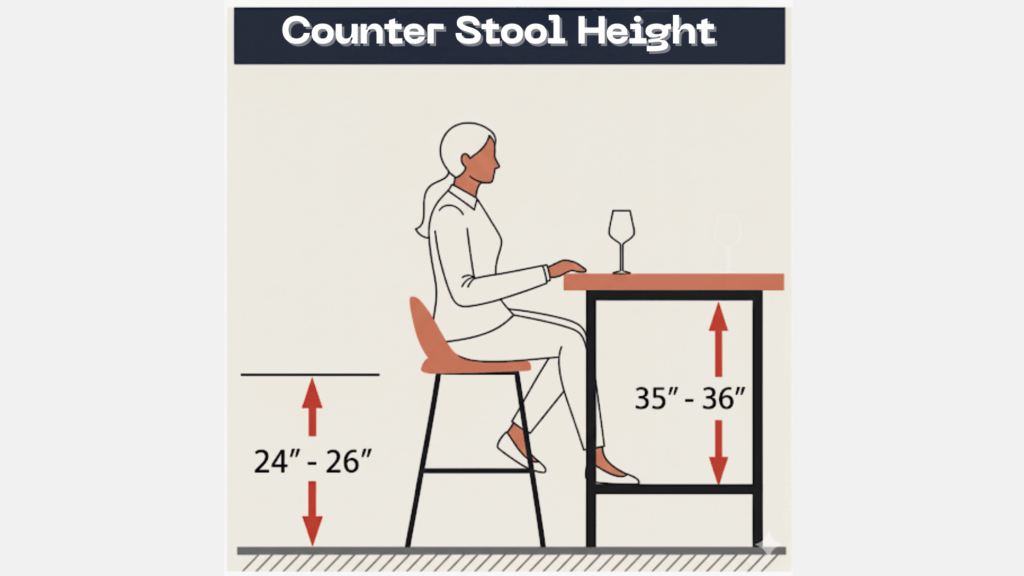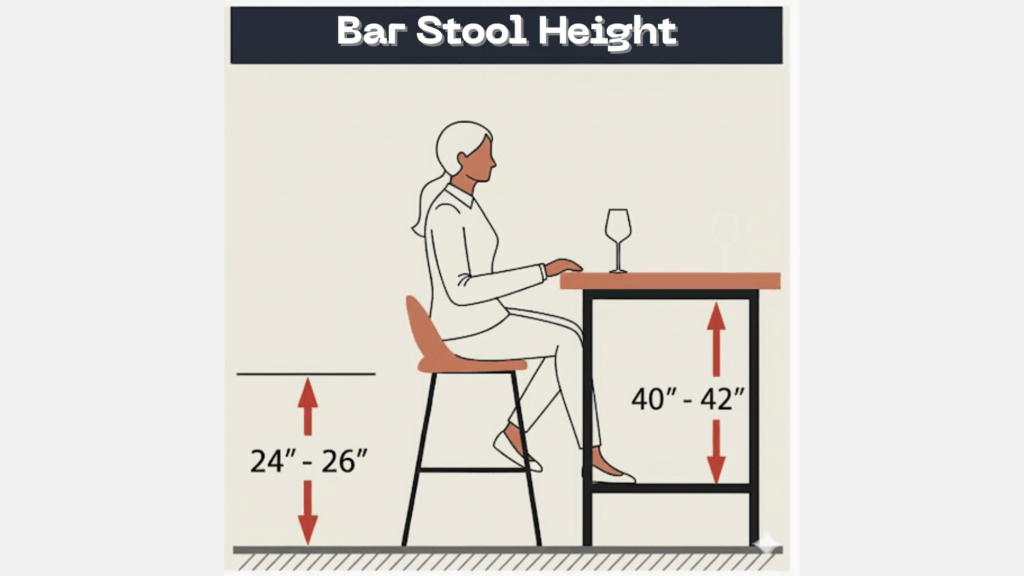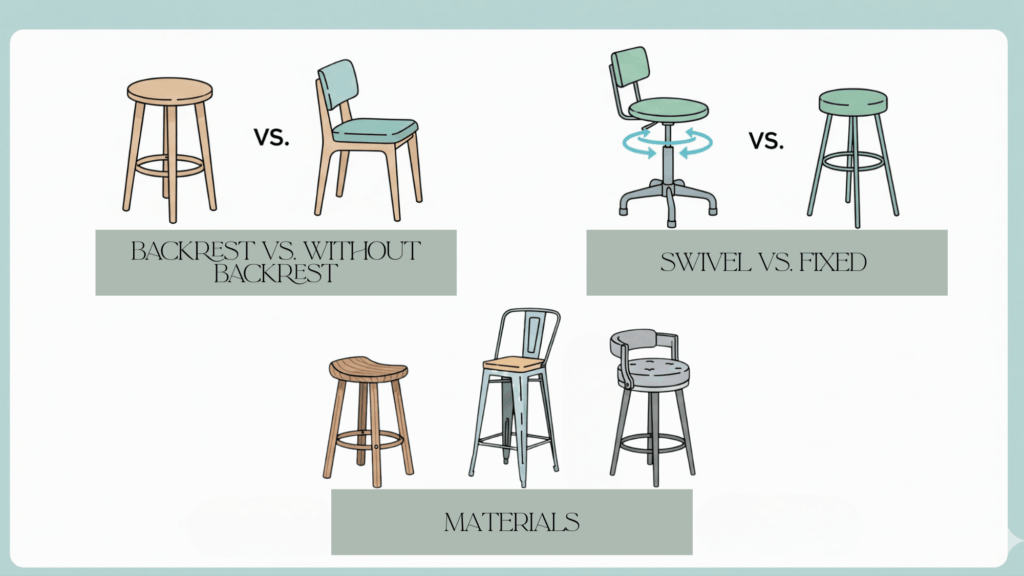Choosing the right stool height may seem like a minor detail, but it can significantly alter the ambiance of your kitchen or bar.
Picture this: you buy stools you love, but when you sit down, your knees hit the counter, or your plate feels way too far away. Suddenly, those stylish stools are a daily frustration.
That’s because stool height isn’t just about looks, it’s about comfort, usability, and making your space feel welcoming.
This guide covers everything you need to know about standard bar stool height, how it differs from counter stools, and how to choose the right fit for your home.
By the end, you’ll be ready to pick stools that work perfectly for your space.
Understanding the Basics: Counter Height vs. Bar Height
Counter Stool Height

If you’re planning seating for a kitchen island or standard countertop, counter stools are the go-to choice.
- Seat Height: 24–27 inches
- Best for: Standard kitchen counters and islands (usually 36 inches tall)
- Common Uses: Quick breakfasts, casual family meals, or a place to sit while cooking
- Style Tip: These stools often feel more casual and blend well with everyday kitchens.
Example: If your family loves sitting around the kitchen island for pancakes on Saturday morning, counter-height stools are the right fit.
Bar Stool Height

For taller spaces like home bars or raised counters, barstools create an elevated look.
- Seat Height: 29–32 inches
- Best for: Home bars, pub tables, or raised countertops (usually 40–42 inches tall)
- Common Uses: Entertaining guests, enjoying drinks, or creating a “bar feel” at home
- Style Tip: These stools often look taller and more dramatic, making them stand out in a room.
Example: If you’ve built a home bar in the basement and want that “pub look,” barstools are what you need.
The key to comfort is the gap between the seat and the underside of your counter or bar. This provides ample room for your legs while maintaining a practical seating height for eating, working, or socializing.
Standard Seat Heights by Stool Type
When selecting the right stool, it’s helpful to know the common seat height ranges for each type. Here’s a quick guide:
- Counter Stools (24–27 inches): Designed for standard kitchen counters and islands, counter stools usually pair with surfaces around 35–40 inches tall.
- Bar Stools (28–33 inches): Ideal for taller home bars or pub tables, bar stools are typically suited for surfaces that measure 40–42 inches.
- Spectator or Extra-Tall Stools (33–36 inches or higher): These are designed for extra-tall counters measuring 44–46 inches or more. They create a dramatic look and are often used in custom bars or unique kitchen layouts.
Quick tip: Think of counter stools as the go-to for kitchens, bar stools for entertaining spaces, and spectator stools for oversized counters.
How to Choose the Right Stool
Choosing the right stool height is key to creating a comfortable and functional seating area at your kitchen counter or home bar. Follow these steps to ensure your stools fit perfectly and improve your space’s usability.
Step 1: Measure Your Counter or Bar Height
The very first thing to do is grab a tape measure. Standard kitchen counters are typically 36 inches tall, whereas most home bars are positioned at around 42 inches.
Knowing this measurement is essential, as it sets the foundation for choosing the correct stool height for comfort and usability.
Step 2: Subtract 10–12 Inches
Once you have your counter or bar height, simply subtract 10–12 inches. This spacing gives you the perfect amount of legroom.
Without it, stools may feel cramped or too high. With it, you’ll sit comfortably and avoid bumping knees, making meals or gatherings more enjoyable.
Step 3: See Real-Life Examples
It’s always easier to visualize with examples. If your counter measures 36 inches, a 25-inch stool is an excellent choice.
For a bar at 42 inches, a 30-inch stool will work perfectly. Even a one-inch difference in stool height can impact both comfort and the natural feel of seating.
Step 4: Consider Adjustable Stools
If flexibility is important, adjustable stools are a great solution. They typically range from 24 to 32 inches, making them suitable for both counters and bars.
With this option, you don’t have to worry about precision measurements; just adjust the stool to the perfect height whenever needed.
Spacing: How Many Stools Fit Comfortably?
Getting stool spacing right is just as important as choosing the correct height. If stools are placed too close together, guests will bump elbows and feel cramped.
Too far apart, and you lose valuable seating. For smaller stools, aim to leave 6–8 inches between each one. Larger or swivel stools need a bit more breathing room, closer to 8–10 inches.
A simple rule of thumb is to plan for 26–30 inches from the center of one seat to the next.
To determine how many stools will fit, measure the total length of your countertop and divide it by the stool width plus the recommended spacing.
When to Consider Non-Standard Heights?
Standard stool sizes work for most kitchens, but there are times when adjusting is the smarter choice.
- Extra-Tall Counters (Above 42 Inches): For these, consider stools around 26 inches for counters or 31 inches for bars, depending on the exact final height.
- Personal Body Proportions: If standard sizes feel awkward, don’t hesitate to size up or down slightly. Comfort should always come first.
Even a small adjustment in stool height can make a big difference, so trust both your measurements and your comfort level.
Other Features to Consider

Height is the starting point, but there are other features that can make a big difference in how your stools fit into your home.
1. Backrest
Backless stools are slim, modern, and tuck neatly under the counter, which is perfect for smaller kitchens or when you want a minimalist look.
However, stools with backs provide much more support and are comfortable for longer sitting sessions. If your island doubles as a workspace or family dinner spot, stools with backs are the smarter option.
2. Swivel vs. Fixed
Swivel stools let you turn easily without dragging the whole stool across the floor, making them convenient for social settings or tight spaces.
They’re also great for kids and guests. Fixed stools, however, are more stable and tend to last longer since they have fewer moving parts. Choose based on your lifestyle and daily use.
3. Materials
The material you choose affects not just the look, but also the upkeep. Upholstered stools feel soft, cozy, and stylish, but can stain if spills are frequent.
Wood and metal stools are easier to clean and extremely durable, which makes them ideal for high-traffic kitchens. Think about who will use the stools and how often.
Common Mistakes People Make
Even though stool sizing is straightforward, people still make these common errors:
- Guessing Instead of Measuring – Eyeballing the counter height almost always leads to buying stools that don’t fit.
- Mixing Counter Stools with Bar Counters – Counter stools at a bar will leave you sitting too low.
- Forgetting Legroom – Always account for countertop overhang so your knees don’t hit.
- Choosing Style over Comfort – That trendy stool might look great, but it feels terrible for long sitting sessions.
Tip: Always test out a stool in-store if possible. If shopping online, double-check the measurements before ordering.
Final Thoughts
The secret to buying the right stool comes down to a simple formula: measure your counter, subtract 10–12 inches, and find a stool that fits within that range.
Getting the height right ensures your space looks polished and feels comfortable. It also prevents the common frustrations of awkward seating.
Combine the right height with thoughtful choices about backrests, swivels, materials, and spacing, and you’ll have stools that your family and guests love to use.
In the end, your stools aren’t just furniture; they’re part of how your kitchen or bar feels day to day. Choose wisely, and they’ll make every meal, coffee break, or cocktail that much more enjoyable.














